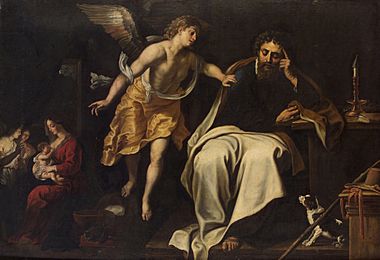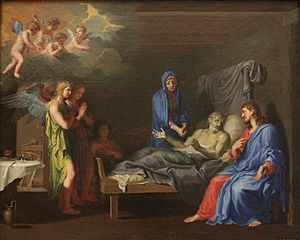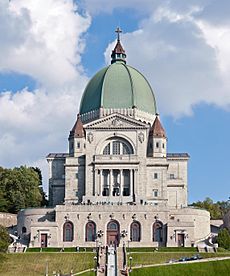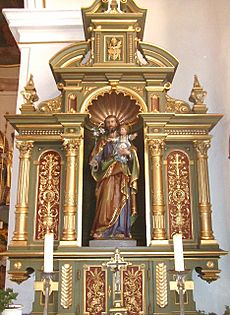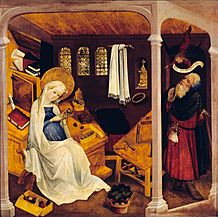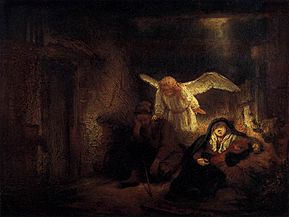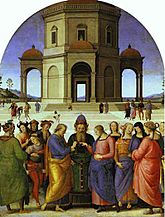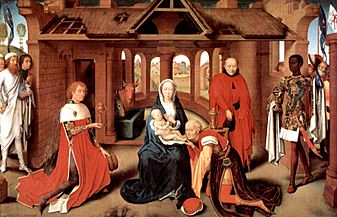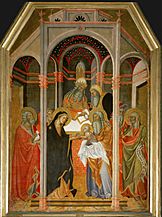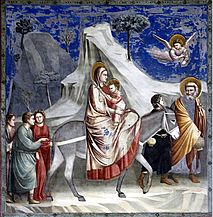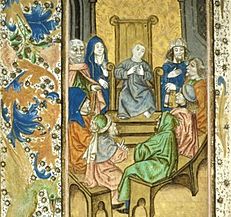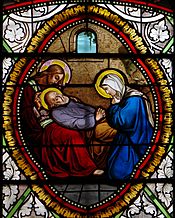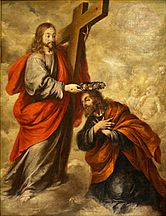Saint Joseph facts for kids
Quick facts for kids SaintJoseph |
|
|---|---|

Saint Joseph with the Infant Jesus by Guido Reni, c. 1635
|
|
| Spouse of the Blessed Virgin Mary Legal father of Jesus Prince and Patron of the Universal Church Guardian of the Holy Family |
|
| Venerated in | All Christian denominations that venerate saints |
| Canonized | Pre-Congregation |
| Feast |
|
| Attributes | Carpenter's square or tools, holding the infant Jesus Christ, staff with lily blossoms, two turtle doves, and the rod of spikenard. |
| Patronage | Catholic Church, among others fathers, workers, married people, persons living in exile, the sick and dying, for a holy death |
Joseph (Hebrew: יוסף, romanized: Yosef; Greek: Ἰωσήφ, romanized: Ioséph) was a man from Nazareth who lived in the 1st century. According to the Gospels in the Bible, he was married to Mary, who was the mother of Jesus. Joseph is known as the legal father of Jesus. The Gospels also mention some of Jesus's brothers. These could have been: (1) sons of Mary and Joseph; (2) sons of Mary, the wife of Clopas, who was Mary's sister; or (3) sons of Joseph from an earlier marriage.
Joseph is honored as Saint Joseph in the Catholic Church, Orthodox Church, Oriental Orthodox Church, and Anglicanism. Some Lutherans also celebrate his feast day. In Catholic traditions, Joseph is seen as the patron saint of workers. He is also linked to several feast days. The month of March is special for Saint Joseph. Pope Pius IX announced him as both the patron and protector of the Catholic Church. He is also the patron of the sick and of a happy death. This is because people believe he died with Jesus and Mary by his side. Joseph is also the patron of many dioceses and places. He is also honored as "most chaste" because he is a patron saint of virgins.
Many honored images of Saint Joseph have been officially crowned by a pontiff. In religious art, he is often shown with lilies or spikenard. As interest in Mary (Mariology) has grown, so has the study of Joseph (Josephology). Since the 1950s, special centers have been created to study Josephology.
Contents
Joseph in the New Testament
The letters of Paul in the Bible are the oldest Christian writings we have. They mention Jesus's mother but not his father. The Gospel of Mark, which was written later, also does not mention Jesus's father.
Joseph first appears in the Gospels of Matthew and Luke. These were likely written around 80–90 AD. Both Gospels include a genealogy of Jesus, showing his family tree back to King David. However, they show different family lines. Matthew follows the royal line through Solomon, while Luke traces another line back to Nathan. Because of this, all the names between David and Joseph are different in the two Gospels.
The stories about Jesus's birth appear only in Matthew and Luke. They explain how Jesus, the Messiah, was born in Bethlehem but grew up in Nazareth. In Matthew, Joseph marries Mary after an angel tells him to. After Jesus is born in Bethlehem, an angel tells Joseph in a dream to take his family to Egypt. This is to escape Herod's plan to kill the children of Bethlehem. After Herod dies, an angel tells Joseph to return. Joseph avoids Herod's son and settles his family in Nazareth in Galilee. In Matthew, baby Jesus is in danger from a cruel king, like Moses. Also, like Moses, Jesus has a father named Joseph who goes to Egypt. Both Josephs receive important dreams about their future.
In Luke's Gospel, Joseph already lives in Nazareth. Jesus is born in Bethlehem because Joseph and Mary travel there for a census. Luke's story does not mention angels visiting Joseph, the killing of the innocents, or a trip to Egypt.
Joseph's last appearance in the Gospels is when Jesus is 12 years old. This story is only in Luke. It describes Jesus's visit to the Temple in Jerusalem during Passover. Joseph is not mentioned after this. The story shows Jesus knew his mission. He speaks to his parents about "my father," meaning God, but they do not understand (Luke 2:41–51).
Christian tradition says Mary was a widow when Jesus was an adult. Joseph is not mentioned at the Wedding at Cana or at Jesus's Crucifixion. If he had been alive at the Crucifixion, he would have been expected to take care of Jesus's body. Instead, Joseph of Arimathea does this. Also, Jesus would not have asked John the Apostle to care for his mother if her husband was alive.
The Gospels do not mention Joseph during Jesus's adult life. However, the synoptic Gospels (Matthew, Mark, Luke) describe a scene where people in Nazareth, Jesus's hometown, doubt him. They know his family and question his status as a prophet. In Mark 6:3, they call Jesus "Mary's son." In Matthew, they call him "the carpenter's son" (Matthew 13:53–55). In Luke 3:23, it says: "Now Jesus himself was about thirty years old when he began his ministry. He was the son, so it was thought, of Joseph, the son of Heli" (Luke 3:21–38). In Luke, the people's tone is positive, but in Mark and Matthew, it is negative. This event is not in John. However, in a similar story, disbelieving neighbors say, "Jesus the son of Joseph, whose father and mother we know" (John 6:41–51).
Gospel Mentions of Saint Joseph
| No. | Event | Matthew | Mark | Luke | John |
|---|---|---|---|---|---|
| 1 | Joseph lived in Nazareth | Luke 2:4 | |||
| 2 | Genealogy of Jesus | Matthew 1:1–17 Solomon to Jacob | Luke 3:23 Nathan to Heli | ||
| 3 | Joseph Betrothed to Mary | Matthew 1:18 | |||
| 4 | Angel visits Joseph (1st dream) | Matthew 1:20–21 | |||
| 5 | Joseph and Mary travel to Bethlehem | Luke 2:1–5 | |||
| 6 | Birth of Jesus | Matthew 1:25 | Luke 2:6–7 | ||
| 7 | Temple presentation | Luke 2:22–24 | |||
| 8 | Angel tells Joseph to flee (2nd dream) | Matthew 2:13 | |||
| 9 | Flight into Egypt | Matthew 2:14–15 | |||
| 10 | Angel tells Joseph to return to Nazareth (3rd dream) | Matthew 2:19–20 | |||
| 11 | Joseph and family settle in Nazareth | Matthew 2:21–23 | Luke 2:39 | ||
| 12 | Finding Jesus in the Temple | Luke 2:41–51 | |||
| 13 | Holy Family | John 6:41–42 | |||
Joseph's Family Tree
- Further information: Genealogy of Jesus
Joseph appears in Luke as Jesus's father and in a different version in Matthew. Both Matthew and Luke show Jesus's family tree back to David. However, they use different sons of David. Matthew follows the royal line through Solomon, while Luke traces another line through Nathan. This means all the names between David and Joseph are different. According to Matthew 1:16, "Jacob begat Joseph the husband of Mary." But according to Luke 3:23, Joseph is said to be "the son of Heli."
There are different ways to explain why the family trees in Matthew and Luke are different. One idea is that Matthew's family tree shows Jesus's legal family line through Joseph, according to Jewish law. Luke's family tree might show his actual physical family line through Mary. Another idea is that Joseph and his father were sons from special marriages called Levirate marriages. A third idea is that Joseph was adopted, and the two family trees show his biological and adopted families.
Joseph's Job

The Gospels mention Joseph's job only once. The Gospel of Matthew[13:55] asks about Jesus:
Is not this the carpenter's son (ho tou tektōnos huios)?
Joseph is called a "tekton" (τέκτων). This word is usually translated as "carpenter." But it is a general word that could mean someone who makes things from different materials. It suggests a skilled worker with wood, iron, or stone. However, early Christian writings always linked Joseph to woodworking. For example, Justin Martyr (who died around 165 AD) wrote that Jesus made yokes and ploughs.
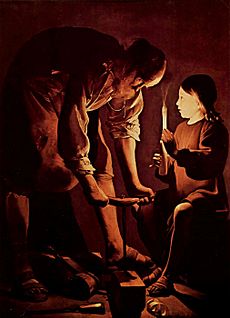
Some experts believe tekton could mean a very skilled craftsman in wood or metal. This person might even run a workshop with several workers. At that time, skilled workers were rare. Geza Vermès said that "carpenter" or "son of a carpenter" in the Jewish Talmud meant a very learned person. He suggests that calling Joseph 'naggar' (a carpenter) could mean he was seen as wise and knew a lot about the Torah.
During Joseph's time, Nazareth was a small village in Galilee. It was about 65 kilometers (40 miles) from Jerusalem. It is hardly mentioned in old non-Christian writings. From what archaeologists have found, the village probably had about 400 people. However, it was only about 6 kilometers (4 miles) from Sepphoris. This city was destroyed in 4 BC and then rebuilt at great cost. Historians think Joseph and later Jesus might have traveled daily to work on the rebuilding of Sepphoris. Some suggest they worked on the large theater there, but this is debated. Other experts believe Joseph and Jesus were general village craftsmen. They would have worked with wood, stone, and metal on many different jobs.
Joseph's Death
The New Testament does not say when Joseph died. But he is never mentioned after Jesus's childhood. Mary is always shown alone, often dressed as a widow, in other texts and art from Jesus's adult life. However, an old story called History of Joseph the Carpenter (from the 5th or 6th century) describes Joseph's peaceful death. It says he died at 111 years old, with Jesus (who was about 19), Mary, and angels present. This scene started appearing in art in the 17th century.
Later Stories About Joseph
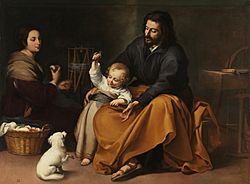
The Gospels said Mary was a virgin when she had Jesus, and Joseph was not his father. Yet, John and Matthew clearly called Jesus "Joseph's son" and "the carpenter's son." Joseph's fatherhood was important to show Jesus's family line back to King David. The Gospels also mentioned Jesus's "brothers and sisters." From the 2nd to the 5th century, writers tried to explain how Jesus could be both the "son of God" and the "son of Joseph."
The first to offer an explanation was the Gospel of James (also called the Protoevangelium of James), written around 150 AD. The original Gospels do not say how old Joseph was. But this author describes him as an old man chosen by God to protect the Virgin Mary. Jesus's brothers are shown as Joseph's children from an earlier marriage.
The History of Joseph the Carpenter, written in the 5th century, is a story about Joseph told by Jesus. It says Joseph was 90 years old and a widower with four sons and two daughters. He was given charge of 12-year-old Mary. She lived in his house and helped raise his youngest son, James the Less. Mary was ready to marry when she was 14 and a half. Joseph's death at 111, with angels present, takes up about half the story. This story also says Mary remained a virgin forever.
Church Leaders' Views
According to Epiphanius, a bishop from Salamis, in his book The Panarion (written 374–375 AD), Joseph had a first wife. With her, he became the father of James and his three brothers (Joses, Simeon, Judah) and two sisters (Salome and Mary, or Salome and Anna). James was the oldest. These children were not Mary's. They were Joseph's children from his first marriage. After Joseph's first wife died, many years later when he was eighty, "he took Mary (mother of Jesus)."
Eusebius of Caesarea writes in his Church History (Book III, chapter 11) that Hegesippus said Clopas was Joseph's brother and Jesus's uncle. Epiphanius adds that Joseph and Cleopas were brothers, sons of "Jacob, nicknamed Panther."
Honoring Saint Joseph

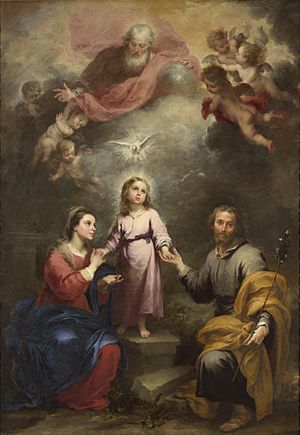
The first records of people formally honoring Saint Joseph date back to the year 800. References to him as Nutritor Domini (meaning "educator/guardian of the Lord") began in the 9th century. This devotion continued to grow until the 14th century.
In the 15th century, important steps were taken by Bernardine of Siena, Pierre d'Ailly, and Jean Gerson. Gerson wrote Consideration sur Saint Joseph and gave sermons about Saint Joseph at the Council of Constance. In 1889, Pope Leo XIII wrote a letter called Quamquam pluries. In it, he asked Catholics to pray to Saint Joseph as the patron of the church. This was because of the challenges the church faced. Leo also said that Saint Joseph "protected his spouse and the Divine Infant with great love and daily care. He regularly worked to earn what was needed for their food and clothing."
Josephology, the study of Saint Joseph in theology, is a newer field of study. In 1989, for the 100th anniversary of Quamquam pluries, Pope John Paul II wrote Redemptoris Custos (Guardian of the Redeemer). This letter explained Saint Joseph's role in God's plan to save humanity.
Joseph, along with the Blessed Virgin Mary and the Child Jesus, makes up the Holy Family. Since Joseph only appears in the birth stories of the Gospels, Jesus is shown as a child when he is with Joseph. The formal honoring of the Holy Family began in the 17th century by François de Laval.
In 1962, Pope John XXIII added Joseph's name to the Canon of the Mass. This is a main prayer in Catholic Mass, and Joseph's name was placed right after the Blessed Virgin Mary's. In 2013, Pope Francis added his name to three other Eucharistic Prayers.
Feast Days
| Feast of Saint Joseph | |
|---|---|

Saint Joseph and the Christ Child by Guido Reni, 1640
|
|
| Observed by | Catholic Church Lutheran Church |
| Celebrations | Carrying blessed fava beans, wearing red-coloured clothing, assembling home altars dedicated to Saint Joseph, attending a Saint Joseph's Day parade |
| Observances | Church attendance at Mass or Divine Service |
| Begins | 19 March |
| Date | Lua error in Module:Wikidata at line 132: attempt to index field 'wikibase' (a nil value). |
| Frequency | annual |
Saint Joseph's Day
March 19, Saint Joseph's Day, has been the main feast day for Saint Joseph in Western Christianity since the 10th century. Catholics, Anglicans, many Lutherans, and other Christian groups celebrate it. In Eastern Orthodoxy, Saint Joseph's feast day is on the First Sunday after the Nativity of Christ. In the Catholic Church, the Feast of Saint Joseph (March 19) is a very important day. If March 19 falls on a Sunday or during Holy Week, the celebration is moved to another date.
Joseph is remembered in the Church of England and the Episcopal Church on March 19.
Popular traditions for Christians celebrating Saint Joseph's Day include going to Mass or a church service. People might wear red clothes, carry dried fava beans that have been blessed, and set up home altars for Saint Joseph.
In Sicily, where many people see Saint Joseph as their patron saint, and in many Italian-American communities, people thank Saint Joseph (San Giuseppe in Italian) for stopping a famine in Sicily long ago. The story says there was a bad drought, and people prayed to their patron saint for rain. They promised that if God answered their prayers through Joseph, they would prepare a big feast to honor him. The rain came, and the people of Sicily made a large banquet. The fava bean was the crop that saved them from starving. It is a traditional part of Saint Joseph's Day altars and customs. Giving food to those in need is also a Saint Joseph's Day custom. In some places, people wear red and eat a Neapolitan pastry called a zeppola on Saint Joseph's Day. Maccu di San Giuseppe is a traditional Sicilian dish made with fava beans. It is prepared on this day.
On a typical Saint Joseph's Day altar, people place flowers, limes, candles, wine, fava beans, special cakes, breads, cookies, and other meatless dishes, including zeppole. Foods often have bread crumbs to look like sawdust, since Joseph was a carpenter. Because the feast is during Lent, no meat was traditionally allowed on the table. The altar usually has three levels, representing the Trinity.
Saint Joseph the Worker
In 1870, Pope Pius IX declared Joseph the patron of the Universal Church. He also started another feast day on the third Sunday after Easter. Pope Pius X later moved this feast to a Wednesday to avoid conflicts with Sunday celebrations. In 1955, Pope Pius XII changed this feast to Saint Joseph the Worker on May 1. This was added to the General Roman Calendar. It is a church holiday that matches International Workers' Day on the same date. This shows Saint Joseph's role as the patron of workers. Pius XII created this feast to honor Saint Joseph and to remind people about the importance of human work.
Espousals of the Blessed Virgin Mary
The Espousals of the Blessed Virgin Mary is celebrated in some church calendars (like that of the Oblates of Saint Joseph) on January 23.
Patris corde and Year of Saint Joseph
On December 8, 2020, Pope Francis released a special letter called Patris corde. This was for the 150th anniversary of Pope Pius IX declaring Saint Joseph the patron of the Universal Church (on December 8, 1870). For the same reason, Pope Francis announced a Year of Saint Joseph, which lasted from December 8, 2020, to December 8, 2021.
Patronage
Pope Pius IX named Saint Joseph the patron of the Universal Church in 1870. Catholic tradition says he died in the "arms of Jesus and Mary." Because of this, he is seen as the perfect example of a faithful person who receives God's grace at the moment of death. He is therefore the patron of a happy death.
Saint Joseph is well known as the patron saint of fathers, families, and virgins. He is also the patron of workers, especially carpenters. He helps expecting mothers and unborn children. Among many others, he is the patron saint of lawyers, immigrants, travelers, and people looking for a house. People pray to him to overcome hesitation and to have a holy death.
Places, Churches, and Institutions
Many cities, towns, and places are named after Saint Joseph. The Spanish name, San Jose, is said to be the most common place name in the world. Famous examples include San José, Costa Rica, and San Jose, California, in the United States. These were named by Spanish colonists. Joseph is the patron saint of the New World. He is also the patron of regions like Carinthia, Styria, Tyrol, and Sicily. Many major cities and dioceses also have him as their patron.
Many churches, monasteries, and other groups are dedicated to Saint Joseph. Saint Joseph's Oratory in Montreal is the largest church in Canada. It has the biggest dome of its kind in the world, after Saint Peter's Basilica in Rome. Around the world, churches named after the saint might be called San Giuseppe (e.g., San Giuseppe dei Teatini), San José (e.g., Metropolitan Cathedral of San José), or São José (e.g., in Porto Alegre, Brazil).
The Sisters of St. Joseph were founded as a religious order in 1650. They have about 14,013 members worldwide. In 1871, the Josephite Fathers of the Catholic Church were created under Joseph's patronage. They aimed to work with the poor. The first Josephites in America focused their work on the newly freed African American community. The Oblates of St. Joseph were founded in 1878 by Joseph Marello. In 1999, their Shrine of Saint Joseph the Guardian of the Redeemer was named after the Pope's letter Redemptoris Custos.
Prayers and Devotions
In the Eastern Orthodox Church, during Saint Joseph's feast day, this hymn is sung:
Verily, Joseph the betrothed, saw clearly in his old age that the foresayings of the Prophets had
been fulfilled openly; for he was given an odd earnest,
receiving inspiration from the angels,
who cried, Glory to God; for he hath bestowed peace on earth.
In the Catholic tradition, there are prayers for the seven joys and seven sorrows of Saint Joseph. Just like there are prayers for the Seven Joys of Mary and Seven Sorrows of Mary. Also, a special prayer called a novena is prayed before Saint Joseph's feast day on March 19. People often pray to Saint Joseph for help with finding a job, daily protection, their calling in life, a happy marriage, and a happy death.
Many respected Catholics have spoken about their devotion to Saint Joseph and how he has helped them. Francis de Sales included Saint Joseph, along with Virgin Mary, as saints to pray to in his 1609 book, Introduction to the Devout Life. Teresa of Ávila said her health improved because of Saint Joseph and suggested him as someone to pray to. Therese of Lisieux said she prayed daily to "Saint Joseph, Father and Protector of Virgins" and felt safe from danger because of it. Pope Pius X wrote a prayer to Saint Joseph that starts:
Glorious St. Joseph, pattern of all who are devoted to toil,
obtain for me the grace to toil, in the spirit of penance,
in order to thereby atone for my many sins …
There is a Catholic tradition that burying a small statue of Saint Joseph on a property can help sell or buy a house. This tradition became very popular online, and some real estate agents in America even bought the statues in large quantities.
Saint Joseph's role in the Catholic Church is summarized by the German theologian Friedrich Justus Knecht:
St. Joseph’s high place in the kingdom of God comes from this, that God chose him to be the guardian and protector of His Son, entrusting him with what was greatest and dearest to Himself, singling him out and especially blessing him for this office. The Church celebrates a Feast in honour of St. Joseph on March 19th, and desires that all the faithful should honour him, ask for his intercession, and imitate his virtues. St. Joseph is the especial patron of the Church. Even as he was the protector of the Child Jesus on earth, so, we believe, is he now the protector of the mystical Body of Jesus, His holy Church. We also especially seek his intercession for a good death, because, having died so blessedly, in the presence and with the assistance of Jesus and Mary, he should be supplicated to obtain for us from Jesus the grace of a happy death.
Joseph in Art
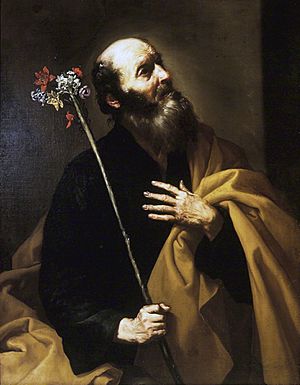
In old mosaics in the basilica of Santa Maria Maggiore (432-40 AD), Joseph is shown as young, bearded, and dressed like a Roman nobleman. Joseph is usually shown with a beard. This is because of Jewish custom. Also, even though the Gospels don't say his age, later stories often show him as an old man when he married Mary. Earlier writers thought this older image was needed to support the belief that Mary remained a virgin forever. However, Jean Gerson preferred to show him as a younger man.
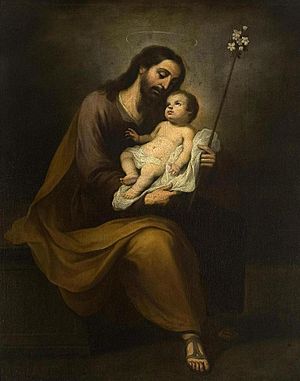
In more recent centuries, as people became more interested in Joseph's role in the Gospels, he became a main figure in art showing the Holy Family. He is now often shown as a younger or even youthful man (especially in Protestant art). He might be shown working as a carpenter or actively taking part in the daily life of Mary and Jesus. He is often shown as an equal and loving family member. However, art critic Waldemar Januszczak points out that Joseph is mostly shown as an old man. He sees this as a way to explain Joseph's lack of power and to symbolize it. In Guido Reni's Nativity, Mary is about 15, and Joseph is about 70. This is because the real focus is on the Virgin Mary. She is young, perfect, and a virgin. Joseph's job is to step aside and let people admire her in a religious way. It takes a very old, grey, kind, and weak man to do that. Joseph is often put in the background of stable scenes. His complex job in art is to stand aside and let his wife be worshipped.
However, Carolyn Wilson disagrees with the old idea that images before the Council of Trent meant to make Joseph seem less important. According to Charlene Villaseñor Black, "Seventeenth-century Spanish and Mexican artists changed how Joseph was seen. They showed him as an important figure, representing him as the young, strong, hardworking head of the Holy Family." In Bartolomé Esteban Murillo's The Two Trinities, Saint Joseph is shown as important as the Virgin Mary.
Full art series about Joseph's life are rare in the Middle Ages. But scenes from the Life of the Virgin or Life of Christ where he is present are much more common. The Mérode Altarpiece from about 1425 is an early example of Joseph having his own panel, where he is shown working as a carpenter. This kind of depiction remained quite rare.
Some statues of Joseph show his staff with flowers on top. This comes from the non-canonical Gospel of James. It tells a story of how Mary's husband was chosen. Widowers in Palestine brought their walking sticks, and only Joseph's stick burst into flower. This showed he was chosen by God. The Golden Legend, which gets its story from the older Gospel of Pseudo-Matthew, tells a similar tale. However, it says all marriageable men from David's family line, not just widowers, were told by the High Priest to bring their rods to the Temple. Some Eastern Orthodox Nativity icons show Joseph being tempted by the Devil (shown as an old man with folded wings) to break off his engagement. They show how he resists this temptation. There are also some paintings where he wears a Jewish hat.
Timeline of Saint Joseph's Life in Art
-
Joseph at work in the Mérode Altarpiece, 1420s, by Robert Campin and his workshop.
-
Joseph's Dream, by Rembrandt, around 1645.
-
Marriage to the Virgin, by Perugino, around 1448.
-
Nativity of Jesus, by Marten de Vos, 1577.
-
The Adoration of the Magi, by Hans Memling, around 1480.
-
Temple presentation, by Bartolo di Fredi, 1388.
-
Dream of Flight, by Daniele Crespi, around 1625.
-
Flight to Egypt, by Giotto, 14th century.
-
Finding in the Temple, from a Book of Hours, 15th century.
-
Death of Joseph, from St. Martin's at Florac.
-
Coronation of Joseph, by Valdés Leal, around 1670.
Music
Marc-Antoine Charpentier, Motet de St Joseph, H.368, for soloists, chorus, and continuo (1690).
See also
 In Spanish: José de Nazaret para niños
In Spanish: José de Nazaret para niños
- Marriage of the Virgin
- Statue of Saint Joseph, Charles Bridge
- Portal:Catholic Church patron saint archive


